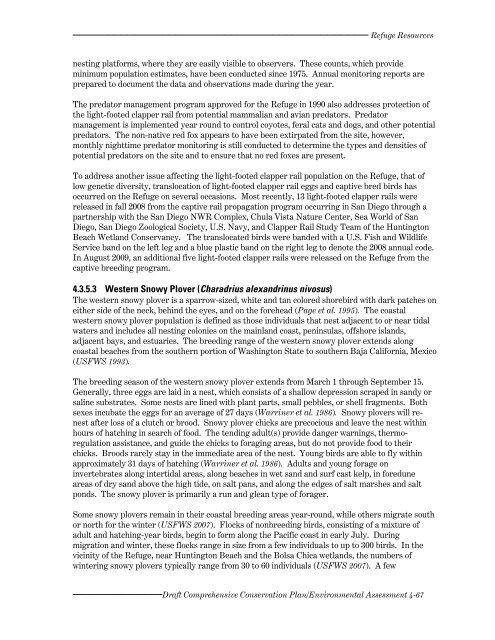Chapters 1 - U.S. Fish and Wildlife Service
Chapters 1 - U.S. Fish and Wildlife Service
Chapters 1 - U.S. Fish and Wildlife Service
You also want an ePaper? Increase the reach of your titles
YUMPU automatically turns print PDFs into web optimized ePapers that Google loves.
Refuge Resources<br />
nesting platforms, where they are easily visible to observers. These counts, which provide<br />
minimum population estimates, have been conducted since 1975. Annual monitoring reports are<br />
prepared to document the data <strong>and</strong> observations made during the year.<br />
The predator management program approved for the Refuge in 1990 also addresses protection of<br />
the light-footed clapper rail from potential mammalian <strong>and</strong> avian predators. Predator<br />
management is implemented year round to control coyotes, feral cats <strong>and</strong> dogs, <strong>and</strong> other potential<br />
predators. The non-native red fox appears to have been extirpated from the site, however,<br />
monthly nighttime predator monitoring is still conducted to determine the types <strong>and</strong> densities of<br />
potential predators on the site <strong>and</strong> to ensure that no red foxes are present.<br />
To address another issue affecting the light-footed clapper rail population on the Refuge, that of<br />
low genetic diversity, translocation of light-footed clapper rail eggs <strong>and</strong> captive bred birds has<br />
occurred on the Refuge on several occasions. Most recently, 13 light-footed clapper rails were<br />
released in fall 2008 from the captive rail propagation program occurring in San Diego through a<br />
partnership with the San Diego NWR Complex, Chula Vista Nature Center, Sea World of San<br />
Diego, San Diego Zoological Society, U.S. Navy, <strong>and</strong> Clapper Rail Study Team of the Huntington<br />
Beach Wetl<strong>and</strong> Conservancy. The translocated birds were b<strong>and</strong>ed with a U.S. <strong>Fish</strong> <strong>and</strong> <strong>Wildlife</strong><br />
<strong>Service</strong> b<strong>and</strong> on the left leg <strong>and</strong> a blue plastic b<strong>and</strong> on the right leg to denote the 2008 annual code.<br />
In August 2009, an additional five light-footed clapper rails were released on the Refuge from the<br />
captive breeding program.<br />
4.3.5.3 Western Snowy Plover (Charadrius alex<strong>and</strong>rinus nivosus)<br />
The western snowy plover is a sparrow-sized, white <strong>and</strong> tan colored shorebird with dark patches on<br />
either side of the neck, behind the eyes, <strong>and</strong> on the forehead (Page et al. 1995). The coastal<br />
western snowy plover population is defined as those individuals that nest adjacent to or near tidal<br />
waters <strong>and</strong> includes all nesting colonies on the mainl<strong>and</strong> coast, peninsulas, offshore isl<strong>and</strong>s,<br />
adjacent bays, <strong>and</strong> estuaries. The breeding range of the western snowy plover extends along<br />
coastal beaches from the southern portion of Washington State to southern Baja California, Mexico<br />
(USFWS 1993).<br />
The breeding season of the western snowy plover extends from March 1 through September 15.<br />
Generally, three eggs are laid in a nest, which consists of a shallow depression scraped in s<strong>and</strong>y or<br />
saline substrates. Some nests are lined with plant parts, small pebbles, or shell fragments. Both<br />
sexes incubate the eggs for an average of 27 days (Warriner et al. 1986). Snowy plovers will renest<br />
after loss of a clutch or brood. Snowy plover chicks are precocious <strong>and</strong> leave the nest within<br />
hours of hatching in search of food. The tending adult(s) provide danger warnings, thermoregulation<br />
assistance, <strong>and</strong> guide the chicks to foraging areas, but do not provide food to their<br />
chicks. Broods rarely stay in the immediate area of the nest. Young birds are able to fly within<br />
approximately 31 days of hatching (Warriner et al. 1986). Adults <strong>and</strong> young forage on<br />
invertebrates along intertidal areas, along beaches in wet s<strong>and</strong> <strong>and</strong> surf cast kelp, in foredune<br />
areas of dry s<strong>and</strong> above the high tide, on salt pans, <strong>and</strong> along the edges of salt marshes <strong>and</strong> salt<br />
ponds. The snowy plover is primarily a run <strong>and</strong> glean type of forager.<br />
Some snowy plovers remain in their coastal breeding areas year-round, while others migrate south<br />
or north for the winter (USFWS 2007). Flocks of nonbreeding birds, consisting of a mixture of<br />
adult <strong>and</strong> hatching-year birds, begin to form along the Pacific coast in early July. During<br />
migration <strong>and</strong> winter, these flocks range in size from a few individuals to up to 300 birds. In the<br />
vicinity of the Refuge, near Huntington Beach <strong>and</strong> the Bolsa Chica wetl<strong>and</strong>s, the numbers of<br />
wintering snowy plovers typically range from 30 to 60 individuals (USFWS 2007). A few<br />
Draft Comprehensive Conservation Plan/Environmental Assessment 4-67

















